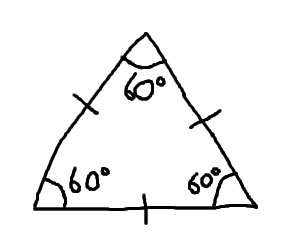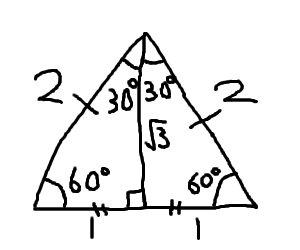Maths Times Infinity > Topics > Trigonometry
Trigonometry
How do you use angles mathematically? We know some angles are bigger or wider than others but how can we put a number on it? We start with the idea that a full revolution should be 360° and work from there. So one degree is one 360th of a full rotation. It follows that 90° is a right angle, 180° is a straight line (or a u-turn) and 45° is a diagonal halfway between horizontal and vertical.
Sine
sin=opp/hyp
The sine of an angle is the ratio between its opposite side and the hypotenuse.
Cosine
cos=adj/hyp
The cosine of an angle is equal to the ratio between its adjacent side and the hypotenuse.
Tangent
tan=opp/adj
The tangent of an angle is the ratio between its opposite and adjacent sides.
The tangent is related to the gradient. If a line cuts the x-axis at a particular angle, the line's gradient will be equal to the tangent of that angle. The reason is that the opposite and adjacent sides of the tangent formula correspond with the rise and run sides of the gradient formula.
Exact Values
For certain angles, the values of sine, cosine and tangent can be found exactly. The main ones are 30°, 45° and 60° (not including 0°, 90° and others outside this range).

First, let's do 45°. Well, the angles in a right-angled triangle are complementary so the other angle is also 45°. That means the triangle is also isosceles. So if we let the bottom side be 1, the right side also has to be 1 and then we can find the hypotenuse using Pythagoras' theorem. You get sqrt(12 + 12) = sqrt(2). Why did we choose 1? Well, only the ratios matter so it's a matter of scale. 1 is nice and simple.
So, sin(45°) = 1/sqrt(2), cos(45°) = 1/sqrt(2) and tan(45°) = 1. So sine and cosine are actually equal with an angle of 45°. This makes sense since we know that sin(90-x) = cos(x).
 | Okay, now let's look at 60°. First take an equilateral triangle. That is, all the sides are equal and all the angles are equal as well (to 60°). |
 | Now we split it right down the middle. This creates two right-angled triangles with 60° and 30° angles. Now we label the sides 2 and therefore the bottom parts are each 1. Using Pythagoras again, we find the height down the middle. It's sqrt(22-12) = sqrt(3). |
